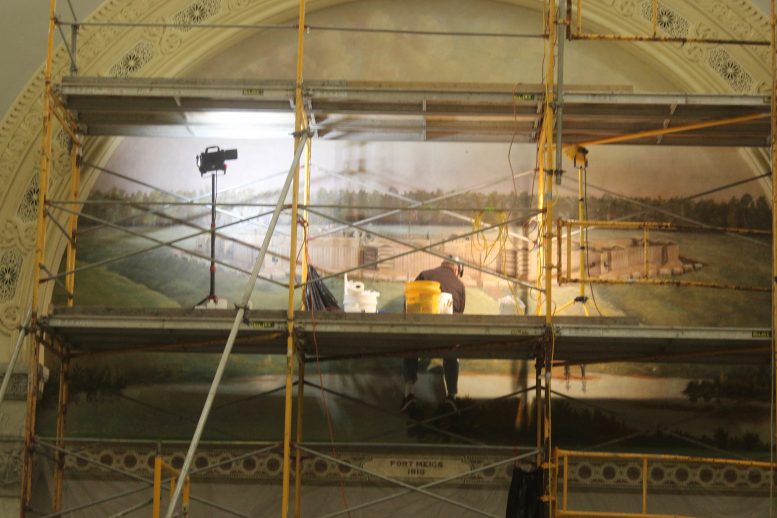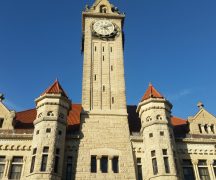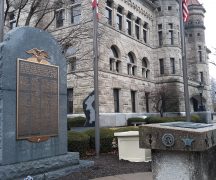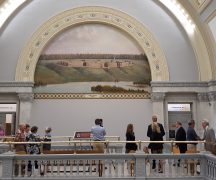By DAVID DUPONT
BG Independent News
Stefan Dedecek is applying a mix of art, science, and craftsmanship to preserve a piece of Wood County history.
For the past several weeks, Dedecek, a conservator with McKay Lodge Conservation Laboratory in Oberlin, has been scaling a jungle gym of scaffolding to reach the mural depicting Fort Meigs that overlooks the third floor of the county courthouse.
As the wheels of justice spin on the floors below, he is painstakingly working to clean the mural’s surface. In areas where the original painted image is gone, he will fill in the missing patches matching the style of the original artist, I.M. Taylor, a former mayor of Bowling Green.
The murals * show the signs of age as well as a previous attempt to preserve them.
“Somebody worked on it before me, and that’s the worst thing,” he said during a break from his work. That restorer some 40 or so years ago applied a thick layer of varnish over the painting. There’s dirt underneath that varnish, Dedecek said. Both need to come off.
That was one of the surprises that a conservator finds, he said. Until the scaffolding had been erected, he hadn’t been able to get a close look at the mural, which depicts Fort Meigs in 1813.
The mural was in worse shape than he anticipated. Still, he’s said he’s about half done removing the varnish.
The mural was painted in oil, not a common medium, directly onto the wall. This contrasts with the way many famous murals such as those in the Sistine Chapel were done. Those had the pigment directly applied on wet surfaces so the paint suffuses the surface.
Here the paint sits on top. As the building settles, and the temperature and humidity changes, the paint can flake off.
Dedecek uses a syringe to inject adhesive directly into the concrete. He’ll use a variety of materials with pigment to fill in patches.
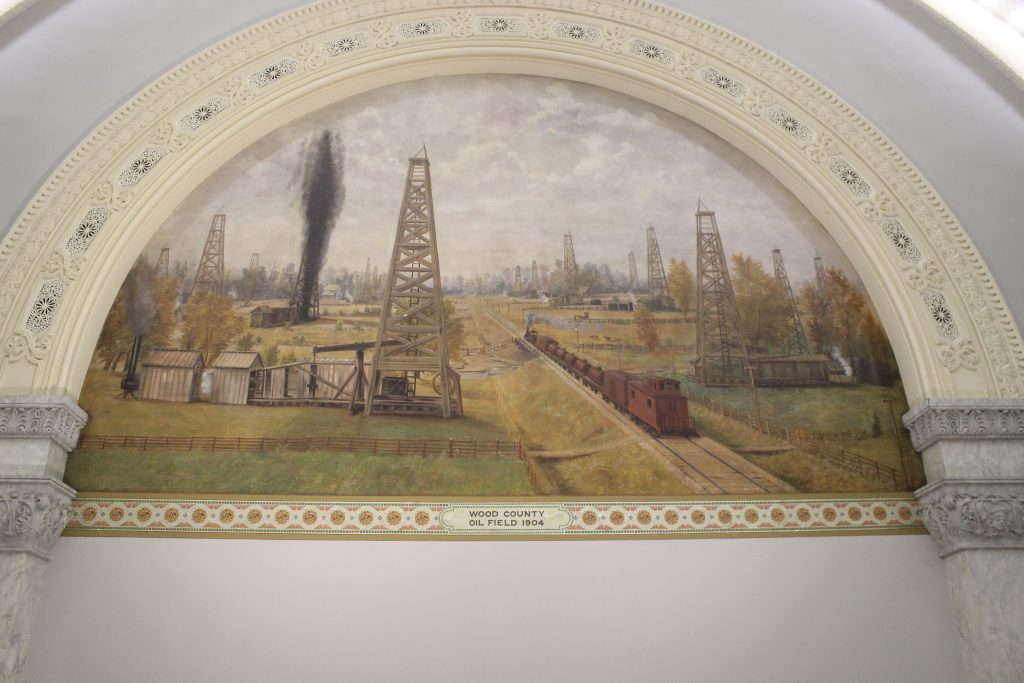
He expects to finish the Fort Meigs mural later this month. Then the scaffolding will be moved to the other staircase, and he’ll work on the mural that depicts an oil field in 1904 during the county’s oil boom.
He expects to have that completed by the end of February.
The county commissioners have appropriated about $70,000 to the project — about $22,000 for the scaffolding and the $47,390 for McKay Lodge.
When the funding was approved Wood County Administrator Andrew Kalmar said the murals are an integral part of the courthouse, which is on the National Register of Historic Places.
Dedecek casts an approving eye on the building with its main glass skylight and outside, its stone roof. As the descendant of Czech clockmakers he especially admires the clock tower.
He grew up surrounded by art in a historic Czech city. He came to the United States where he studied art at the Minneapolis College of Art and Design in Minneapolis. His love of art history and science led him into his career as a conservator. He studied chemistry at Macalester College, St. Paul, Minnesota, and then earned his Master of Science in Art Conservation from University of Delaware-Winterthur Museum Conservation Program in 1993.
He has worked in Europe, Argentina, and throughout the United States.
McKay Lodge is a contractor with the U.S. Government Services Administration. As a painting conservator he’s worked preserving the murals, frescoes and painted plaster walls at the Federal Courthouse in Erie, Pennsylvania and at the Metzenbaum U.S. Courthouse in Cleveland.
The size of the project does not change the approach though. “Sometimes grandma brings little heirloom,” Dedecek said. They will tell her the cost of the conservation exceed the monetary value of the item. Yet she wants it done.
“We treat it same as a Picasso,” he said.
Art conservators are guided by certain ethical principles. They cannot harm the object, nor alter it. They must keep it as close to original as possible. Nothing should change the appearance of the original. If changes have been made previously, these should be removed. Everything the conservator does should be reversible.
Much progress has been made in the craft of art preservation since the 1970s, he said.
Once completed the murals should be in position to better withstand the ravages of time, but nothing is permanent, Dedecek said. “The deterioration of the building itself will continue to affect the painting.”
He’s uncertain how much people will be able to notice when the work is done. He hopes they do, he said, adding, “sometimes they are very subtle.”
And some passers by are noticing the murals for the first time as he works on them. They even ask if he is painting them.
The murals may not be his creation, still when he’s finished, Dedecek said: “My soul is left there.”
*The story originally stated the murals were painted in 1910-11, but those dates have been called into question.

